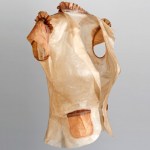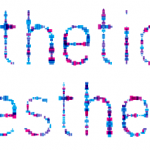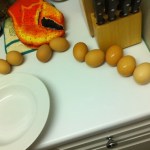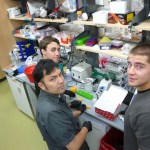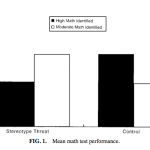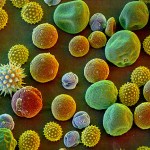
Check out these iGEM twitter pages to follow the antics of iGEM teams around the world this summer (and let me know if I missed any teams)!
iGEM headquarters @igem
Biotec Dresden @igem_biotec
Bielefeld @iGEM_Bielefeld
Brazil @igembrasil
Calgary @iGEMCalgary
Cambridge @camgem
Canada @igemcanada
Chiba @Chiba_iGEM2010
Debrecen @debrecenigem
DTU @igemdtu2010
Edinburgh @IlluminatiED
EPFLausanne @IGEM_EPFL
Freiburg @FreiburgBioware
Georgia State @iGEMGSU
Georgia Tech @georgiatechigem
Groningen @igemgroningen
Harvard @harvardigem
IIT Delhi @iitdelhiigem
Imperial @imperialigem
Illinois Software @…
I don't usually like to post links from BoingBoing because I imagine everyone has already seen this already, but as it is about some of my favorite things (synthetic biology, biomaterials, and fashion) I couldn't resist!
Designer Suzanne Lee makes clothes using cellulose-based fabrics made entirely by cultures of yeast and bacteria. From what I could understand from the ecouterre article, the process is similar to how kombucha is made, using the microbes to ferment a green tea mixture, although I thought that the film that forms on top of the fermenting tea in kombucha is some sort of yeast/…
I am thrilled to announce that I will be one of the Synthetic Aesthetics residents this fall. Synthetic Aesthetics is a new program run through Stanford and the University of Edinburgh and funded by the National Science Foundation and the UK's Engineering and Physical Sciences Research Council that asks the question "how would you design nature?":
Synthetic Biology is a new approach to engineering biology, generally defined as the application of engineering principles to the complexity of biology. Biology has become a new material for engineering. From biological circuits made from DNA to…
Science is cooking done in a lab. Mixing carefully (or not so carefully) measured components, heating, cooling, observing phase transitions, exploring the behavior of animal and plant proteins, exploring the properties of different chemicals, slowly changing variables to optimizing procedures. Often, feeding bacteria has a lot in common with feeding people, and I have to admit that freshly autoclaved yeast media smells delicious.
Said another way, cooking is science where at least you can usually eat the failures. My fiancé and I have been failing at making soft-boiled eggs for quite some…
There's a terrific new article about synthetic biology in SEED by James King, go check it out! Here's a little taste:
"Synthetic biology" is a catch-all label liberally applied to a host of methods for designing and constructing living things. Given the term's multiple definitions, one of Synthia's most immediately useful applications may be to place the achievement it represents within the context of synthetic biology's various flavors, in order to clarify what the creation of artificial life might actually mean.
The first (and sometimes 3rd, 12th, 25th, 134th...) step of any genetic engineering experiment is often extracting DNA from some organism or another. While novel gene synthesis technology will likely make this procedure obsolete, these days it's still most economical to do it by hand. Extracting DNA from fruits like strawberries has also seen a popular resurgence thanks to groups like DIYbio, with instructions for making DNA shots available online for a fun and nerdy party activity. Today my iGEM team extracted RNA from strawberries and oranges to isolate the genes responsible for strawberry…
iGEM officially starts for the Harvard team tomorrow for some good old-fashioned fun with BioBricks, arabidopsis, protein-based sweeteners, and shRNA! Our goal is to make a system for genetically engineering plants safely and easily with some hopefully fun and useful applications in the short term. iGEM (the International Genetically Engineered Machines competition) is about fun and open science, so we hope you enjoy following along with our adventure on our wiki, blog, twitter, or even become a fan on facebook. As a proud teaching fellow I'll be posting updates here periodically all summer,…
In the recent articles, blog posts, and comment threads about possible biological reasons for the continued gender disparity in tenured math and science faculty positions, the discussion seems to be divided between two groups: those who emphasize the social and cultural aspects involved in gender and intelligence, and those who emphasize the scientific evidence of standardized test performance. The science team rails against "political correctness," claiming that by questioning the merits and motives of scientific hypotheses of differences in innate intelligence between different groups of…
Another day, another article about how women are biologically inferior to men when it comes to high-level math and science. The fact that this one comes from the New York Times Science section, a newspaper I typically respect very highly, is all the more tragic and frustrating. I don't have time today to write with as much depth and ferocity as I would like to, but I want to just say that I find it outrageous that the New York Times would publish something so obviously sexist and one-sided about such a complex, nuanced, and important topic under the headline "Daring to Discuss Women in…
In a recent conversation about the safety and ethics of synthetic biology in the wake of the announcement of the synthetic genome, many of the professors I was chatting with commented on how they hoped new synthetic biology technology would lead to bacteria that could eat the oil spilling into the gulf of mexico even as I type this right now. Of course, the "technology" for oil eating bacteria already exists and have already been used for clean up in previous oil spills--many naturally occurring species of bacteria can already break down the hydrocarbons in crude oil. The natural oil eaters…
Silk is an amazing biomaterial, cultivated and prized for more than 5,000 years. The silk threads that we weave into our shiny fabrics are actually enormous protein crystals produced by insects. This industrial silk that you can buy at the mall is made by silkworms, which use the silk to form the cocoon that protects them as they transform into moths. Many other species of insect also produce silk proteins to protect themselves or their eggs, get around, or catch their prey, but none in such enormous quantity in such easy to harvest packages as the silkworm. Silks from different species are…
The World Science Festival starts today in New York City with tons of exciting events from BioArt to The Science of Star Trek and all sorts of great stuff in between! If you can't make it to New York there's also a twitter page and a blog here on ScienceBlogs accompanying the event that you can follow along with, and I had the chance to write a post over there about how I got into science as a kid. So go check it out! "What if Science Were Like Sports?" Here's a little teaser:
Biosafety has been on everyone's mind this week after the announcement of the J. Craig Venter Institute's successful transplantation of a synthetic genome. What horrible pathogen will future bioengineers be able to design? What unforeseeable environmental catastrophe will befall us upon the release of genetically engineered bacteria? These are hugely important questions as research in synthetic biology moves forward, being discussed in congressional hearings and as an integral part of every new synthetic biology design.
As the major proposed goal of a great deal of synthetic biology research…
I'm realizing that perhaps in yesterday's post I took everyone's love and understanding of postmodern feminist theory for granted so I'm going to start a little series of posts that I think will slowly introduce some of the issues that I spend a lot of time thinking about and hope that other people will too. Today I'm going to jump right into it by posting the essay I wrote for a horrible class I took about science and religion called Belief Options for a Practicing Scientist. The assignment was to write a five page essay on what the best belief option for a scientist is and why. I think that…
I love this quote from the XKCD blog:
The role of gender in society is the most complicated thing I've ever spent a lot of time learning about, and I've spent a lot of time learning about quantum mechanics.
Many scientists try very hard to de-emphasize this complexity, trying to reduce "human nature" down to parts and genes and behaviors that can be explained by evolutionary mechanisms, by hormones, by genetics. It's not nature vs. nurture and it's not just male and female, it's nature and nurture and infinite variations along a culturally and biologically mediated gender continuum. By…
I had the pleasure of chatting with John Hawks about the two big science news stories of the past few months, the synthetic genome and the Neandertal genome, for Science Saturday at bloggingheads.tv.
John is a professor of anthropology at the University of Wisconsin who studies population genetics of ancient humans, as well as a terrific teacher. I learned a lot of really fascinating things about how people study fossils and trace human evolution and it was interesting to find some connections between the two stories! As he mentions on his blog, we didn't once mention synthetic Neandertals…
I don't get nearly as many emails asking for advice as I'm sure the lovely and talented Dr. Isis does, and I'm not sure if my advice can compare in quality and sassiness to hers, but I want to address the questions I get most often--how do you get into synthetic biology if your background is in something else, and how do you get into a PhD in synthetic biology?
While there are an increasing number of labs that work primarily on synthetic biology and schools with undergraduate iGEM teams, there are still very few (if any?) graduate programs that will write "Synthetic Biology" on your diploma,…
There is big excitement in lab today--my very talented labmate Jake has won the Division of Medical Sciences graduate student science haiku contest!!! Here is his burrito winning entry:
Green lasers on high
Shining to illuminate
Synechococcus!
It's definitely haiku day over here, so share your science haikus in the comments for maximum fun!
There is an interesting and very thoughtful piece by Craig Venter and Daniel Gibson in today's Wall Street Journal going through what their breakthrough is and what it isn't, where they see the project going in the future, and why public discussion is important:
[Previous genetic engineers] did not create life in a test tube, nor did we create life from scratch. We transformed existing life into new life. We also did not design and build a new chromosome from nothing. Rather, using only digitized information, we synthesized a modified version of the naturally occurring Mycoplasma mycoides…
A recent New York Times article tells us that what many people call food allergies are actually simple intolerances, and that allergies are being dangerously overdiagnosed. What is a true food allergy, and what can be done to fix them besides banning peanuts from schools and avoiding foods that make us itchy?
Allergies are caused by an inappropriate immune response to common things in the environment. Usually the offending allergen is a protein that comes from plants or animals like pollen or dander. Instead of the immune system recognizing that these proteins are harmless, it instead…

